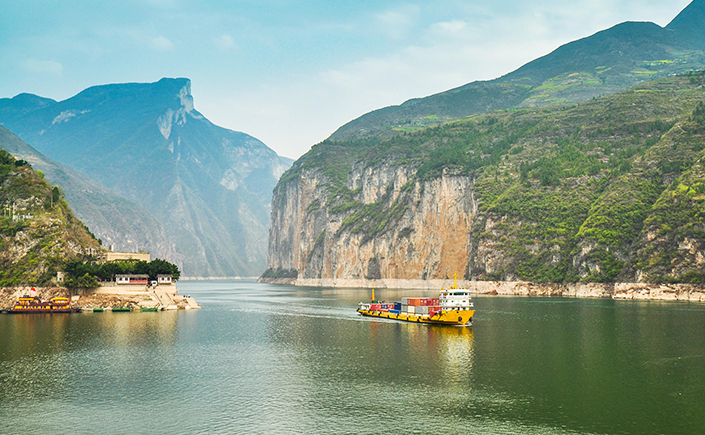
China’s rapid economic growth has taken a toll on its environment, threatening the work that ecosystems do for free in the form of “ecosystem services” that benefit people. For example, healthy ecosystems store carbon, filter nutrients to provide clean water, prevent erosion, mitigate floods and sandstorms, and provide habitats that preserve biodiversity.
In 2000 China began investing in the restoration of its ecosystems to increase its “natural capital.” By 2009 the country had spent more than $50 billion on the effort. Writing in a recent issue of Science, a panel of researchers—including the U’s Stephen Polasky, Regents Professor of Applied Economics—reports a favorable result. Six of seven ecosystem services improved during the decade 2000-2010, and China’s ecosystem-restoration policies likely contributed significantly to four: carbon sequestration, soil and water retention, and sandstorm mitigation.
Polasky, along with coauthors from the United States and China, says the Chinese experience shows that improving ecosystem services can coexist with economic growth—a lesson that could be applied in other countries, including the United States. Also, its benefits ought to appeal to parties on both sides of the political divide.
“Ecosystem conservation often can be shown to make good sense for society by providing valuable services like flood control or clean water,” Polasky says. “Providing a good environment and saving costs—for example, for water filtration or flood damage—is something that both Democrats and Republicans should agree on.”
China is already using the results of the assessment to improve targeting of ecosystem restoration efforts.
Out of disaster, hope
The value of ecosystem services became apparent during the 1990s. Rapid economic growth in China had lifted hundreds of millions of people out of poverty. But in 1998, floods along the Yangtze River, swollen by runoff from widespread deforestation and erosion, killed thousands of people, left 13.2 million homeless, and caused some $36 billion in property damage.
That tragedy led to the world’s largest government-financed program to pay for ecosystem services: the Natural Forest Conservation Program and the Sloping Land Conversion Program (SLCP). These efforts stretched across the entire Chinese mainland, involving more than 120 million farmers in 32 million households in the SLCP alone. The stated goals were to reduce natural disaster risks by restoring forests and grasslands, while improving livelihood options and alleviating poverty. In many cases, agricultural lands were removed from crop production and planted in trees or other perennial vegetation.
Working with colleagues at China’s Ministry of Environmental Protection and the Chinese Academy of Sciences, Polasky assessed changes in seven ecosystem services to see if investments in ecosystem restoration were paying dividends. The researchers found increases (improvements) in six of seven outcomes from 2000 to 2010:
Food production: +38.5%
Carbon sequestration: +23.4%
Soil retention: +12.9%
Flood mitigation: +12.7%
Sandstorm prevention: +6.1%
Water retention: +3.6%
Habitat provision: -3.1%
The changes varied widely from region to region. One notable success was that ecosystem services in the aggregate rose in western China’s Loess Plateau, which suffers some of the world’s most severe soil erosion.
Now “we are helping with planning how the results can be used in the next generation of policies on land use zoning in China,” says Polasky. “[These include] ‘Ecological Function Conservation Areas’ and Ecological Redlining —zones that rule out intense development—as well as metrics of ‘Gross Ecosystem Product’— measuring the value of ecosystem services.”
Trans-Pacific collaboration
Polasky’s involvement in the study grew from his position as a co-founder of the Natural Capital Project (NatCap), a partnership of the U of M, Stanford University, the Nature Conservancy and the World Wildlife Fund that began in 2006. NatCap projects aim to ensure that important societal decisions around the world take account of their impacts on nature and the consequent impacts on human well-being. At the U, NatCap’s primary home is the Institute on the Environment.
Through NatCap, Polasky began working with Stanford ecologist and Science paper coauthor Gretchen Daily, who had several connections to China. One was another coauthor, Professor Zhiyun Ouyang of the Chinese Academy of Sciences, with whom Polasky has worked closely since 2011, when he first visited Ouyang in Beijing.
The kind of data gathered by NatCap scientists can lead to incentives for long-term environmental stewardship, Polasky says.
“Currently, most environmental impacts are invisible in markets and policy realms,” he notes. “Overcoming this invisibility will require better science to understand how our actions transform ecosystems and how this affects the provision of goods and services that we value.”